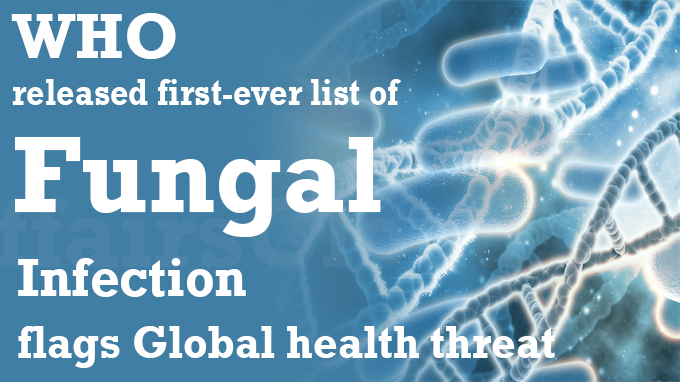 The World Health Organization (WHO) has released the “WHO Fungal Priority Pathogens List” (WHO FPPL), a report that highlights the first-ever list of fungal “priority pathogens,” a catalogue of the 19 fungi that pose the greatest harm to public health.
The World Health Organization (WHO) has released the “WHO Fungal Priority Pathogens List” (WHO FPPL), a report that highlights the first-ever list of fungal “priority pathogens,” a catalogue of the 19 fungi that pose the greatest harm to public health.
- The report is based on research conducted by the University of Sydney in Australia.
‘WHO Fungal Priority Pathogens List’ (WHO FPPL)
The WHO FPPL is the first global initiative to systematically prioritize fungal pathogens based on unmet Research & Development (R&D) requirements and perceived public health importance.
- Aim: To focus and promote more research and policy measures to boost the global response to fungal infections and antifungal resistance.
Three Priority Categories: The WHO FPPL is divided into three categories: Critical, High and Medium Priority.
- The fungal pathogens in each priority category are ranked mostly based on their public health impact and/or emerging antifungal resistance risk.
i.The ‘Critical’ group consists of Candida albicans, Cryptococcus neoformans, Aspergillus fumigatus, and Candida auris, a highly drug-resistant pathogen that has caused numerous outbreaks in hospitals all over the world.
ii.The ‘High’ group includes a range of other fungi from the Candida family, as well as others such as Mucorales, a group containing the fungi that cause mucormycosis, or ” Black Fungus”.
- The Black Fungus infection was spread rapidly in critically ill patients, notably in India, during the COVID-19 pandemic.
iii.The ‘Medium’ group consists of a number of other fungi, including Coccidioides spp and Cryptococcus gattii.
Fungal Pathogens
i.Fungal pathogens are a clear threat to public health since they are becoming more widespread and resistant to treatment.
- As of now, just four classes of antifungal medications are available, with a few candidates in the trial stage.
ii.The majority of fungal pathogens lack rapid and sensitive diagnostics, and those that exist are not generally available or economical on a worldwide scale.
iii.Invasive variants of these fungal infections frequently affect critically ill patients and those with significant immune system-related problems.
- Cancer, HIV/AIDS, organ transplants, chronic respiratory disease, and post-primary tuberculosis infection are among the categories very much at risk of invasive fungal infections.
iv.The key recommended actions to curb the pathogens are as follows:
- Strengthening laboratory capacity and surveillance
- Sustaining investments in research, development, and innovation
- Enhancing public health interventions for prevention and control
Recent Related News:
According to the Joint Monitoring Programme (JMP) report by the World Health Organization (WHO) and the United Nations Children’s Fund (UNICEF) titled “Progress on WASH in health care facilities 2000–2021: special focus on WASH and infection prevention and control (IPC)”, in 2021, around half of healthcare facilities across the world lack basic hygiene services with water and soap or alcohol-based hand rub, where patients receive care and at toilets in these facilities.
About World Health Organization (WHO):
Director-General – Tedros Adhanom Ghebreyesus
Headquarters – Geneva, Switzerland
Establishment – 1948




